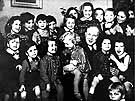
|
|
|

|

|

|

|
|
Click on an image to see a larger, more detailed picture.
|
|
|
|
|
| 1943: Death and Resistance |

|
pg. 489 |

|
|
|
|
| |
 This group portrait of Danish-Jewish children was taken in a children's home in Sweden after their escape from Denmark. The rescue of Danish Jewry was one of the few positive stories in the tragic annals of the Holocaust. These Jewish children unknowingly defied all odds by surviving the genocidal intentions of the Nazis.
This group portrait of Danish-Jewish children was taken in a children's home in Sweden after their escape from Denmark. The rescue of Danish Jewry was one of the few positive stories in the tragic annals of the Holocaust. These Jewish children unknowingly defied all odds by surviving the genocidal intentions of the Nazis.
Photo: Frihedsmuseet / United States Holocaust Memorial Museum Photo Archive
|
 A Swedish policeman accompanies a newly arrived Danish-Jewish refugee to the welfare office in Rebslagergade, Sweden. Swedish participation was critical to the success of the rescue operation. Not only did the government proclaim its willingness to accept all Jewish refugees from Denmark, but the Swedish Red Cross helped save the approximately 500 Danish Jews who were deported to the Theresienstadt camp/ghetto in Czechoslovakia.
A Swedish policeman accompanies a newly arrived Danish-Jewish refugee to the welfare office in Rebslagergade, Sweden. Swedish participation was critical to the success of the rescue operation. Not only did the government proclaim its willingness to accept all Jewish refugees from Denmark, but the Swedish Red Cross helped save the approximately 500 Danish Jews who were deported to the Theresienstadt camp/ghetto in Czechoslovakia.
Photo: Frihedsmuseet / United States Holocaust Memorial Museum Photo Archive
|
 Denmark's Rescue of Jews
Denmark's Rescue of Jews
The heroic actions of the Danish people during the autumn of 1943 saved nearly all of Denmark's Jews from certain death in Nazi concentration camps. After the Germans occupied the country in 1940, the Danish government resisted Nazi pressure to hand over its Jews. In 1943, however, the Danes intensified resistance, prompting a harsh Nazi reaction. Imposing martial law, the Germans in October began to arrest and deport Danish Jews. Reacting spontaneously, Danes alerted and hid the Jews, helping them to the coast and organizing secret passage across the sea to Sweden (pictured). The unassuming Danish rescuers included police, fishermen, and members of church and social organizations. Over the course of three weeks, the Danish people transported more than 7200 Jews and almost 700 of their non-Jewish relatives to safety aboard Danish fishing vessels. The Nazis did capture 464 Jews, whom they sent to the Theresienstadt, Czechoslovakia, camp/ghetto. Aid continued, nonetheless, as the Danish public sent food parcels to their Jewish countrymen imprisoned in Theresienstadt. Just before the conclusion of the war, in spring 1945, negotiations rescued most of these Jews through an agreement that transferred many Scandinavian nationals from concentration camps to Sweden.
Photo: Frihedsmuseet / United States Holocaust Memorial Museum Photo Archive
|
|

|

|

|

|
 October 16, 1943: Two days after a violent Jewish revolt at the Sobibór death camp, SS chief Heinrich Himmler orders the camp destroyed.
October 16, 1943: Two days after a violent Jewish revolt at the Sobibór death camp, SS chief Heinrich Himmler orders the camp destroyed.
|
 October 16, 1943: Germans looking for Jews in Rome conduct house-to-house searches. About 1000 Jews are briefly held at Rome's Collegio Militare, then deported to Auschwitz. 477 Jews are sheltered in the Vatican, and another 4238 find sanctuary in convents and monasteries throughout Rome. Nevertheless, by this date more than 8300 Italian Jews have been deported to Auschwitz.
October 16, 1943: Germans looking for Jews in Rome conduct house-to-house searches. About 1000 Jews are briefly held at Rome's Collegio Militare, then deported to Auschwitz. 477 Jews are sheltered in the Vatican, and another 4238 find sanctuary in convents and monasteries throughout Rome. Nevertheless, by this date more than 8300 Italian Jews have been deported to Auschwitz.
|
|
|
|
|
| 1943: Death and Resistance |

|
pg. 489 |

|
|
The Holocaust Chronicle
© 2009 Publications International, Ltd.
|
|
